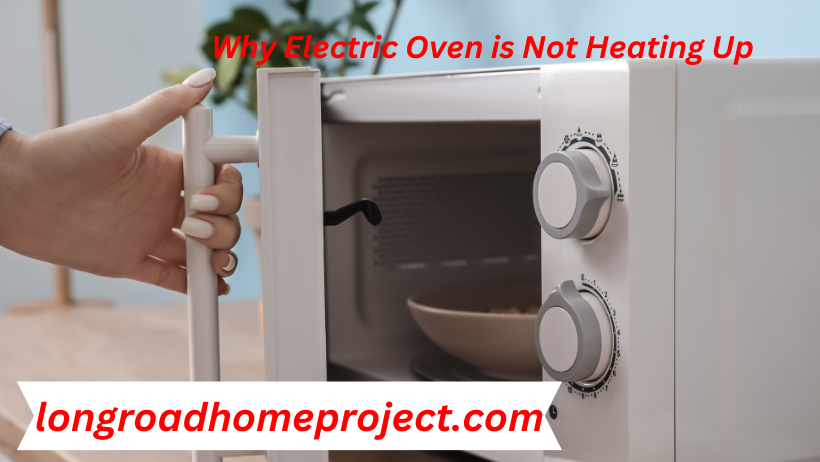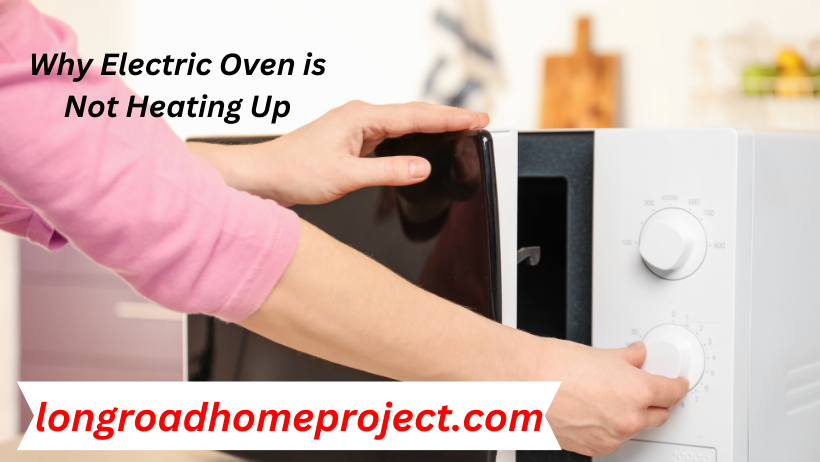As an Amazon Associate I earn from qualifying purchases.
An electric oven may not heat up due to a faulty heating element or a malfunctioning thermostat. Other common issues include a tripped circuit breaker or a defective oven control board.
Experiencing an electric oven that fails to heat can be frustrating, especially when it disrupts meal preparation. Your oven relies on various components functioning in harmony, and when one missteps, it can lead to ineffective heating. The heating element, crucial for cooking and baking, might burn out or lose connection.
Meanwhile, the thermostat, responsible for temperature regulation, may inaccurately read or fail to engage the heating cycle. Electrical problems, such as a tripped circuit breaker or a wiring fault, could cut power to the oven, preventing operation altogether. Regular inspection and maintenance can preempt these issues, ensuring that your oven remains reliable for your culinary endeavors. Consult a professional technician if you’ve troubleshooted common causes without success, as precise diagnostics are required for safe and effective repairs.
Symptoms Of A Faulty Electric Oven
Is dinner still raw, even after an hour in the oven? An oven that does not heat up can halt meal preparation in its tracks. Identifying the common symptoms of a faulty electric oven is the first step to baking bliss. Let’s unravel these mysteries with clarity!
Inconsistent Temperatures
- The oven struggles to maintain the set temperature.
- Food cooks unevenly, with some parts overcooked.
- The preheat indicator flickers or fails to steady.
Setting the controls only to find varied cooking results indicates an issue. Baked goods appear undone or burnt at the edges. Temperature swings disrupt the cooking process. Use an oven thermometer to check accuracy.
No Heat Generation
- The oven power light is on, but the oven stays cold.
- Controls seem operational, yet the heating elements remain unresponsive.
When an oven fails to warm up, check for power. If other functions work, the element might need replacement. A non-heating oven demands immediate attention for continued kitchen joys.
Tips: Regular maintenance can prevent these issues. Yearly inspections and cleanings keep ovens in top shape.
Common Culprits Behind The Cold
Finding your electric oven cold when it should be hot enough to cook a feast? Several culprits could be to blame for your kitchen conundrum. Let’s troubleshoot and uncover the common culprits behind the cold, so you can get back to baking in no time!
Malfunctioning Heating Elements
Heating elements are the muscles of an oven, striving to get and stay hot. When they fail, your oven feels more like a refrigerator. Look out for these signs:
- No glow: Good elements glow red; no glow often means no go.
- Blistering: Splotches or blisters on the element suggest it’s time for a change.
- Physical damage: Any breaks or warps in the element can halt heat.
To test an element, power off your oven and use a multimeter. A malfunctioning element won’t show continuity and needs replacement.
Faulty Temperature Sensors
Temperature sensors are the secret agents of ovens, spying on heat levels. A faulty sensor gives false reports, tricking your oven into a cold spell. Symptoms include:
- Unpredictable temperatures: Your oven might underheat or overheat.
- Error codes: Your oven may flash codes at you. Consult the manual!
- Inconsistent baking: Cakes uneven? Are cookies not golden? Suspect the sensor.
Use a multimeter to check sensor resistance. Follow the oven’s manual for the correct reading. A sensor far off from the standard needs replacing.

Troubleshooting 101
Is your electric oven refusing to heat up? Stay calm. Many issues have simple DIY fixes. Start with the basics before calling a pro. Let’s dive into troubleshooting to find the culprit.
Visual Inspection
Begin with basic checks. Make sure the oven is plugged in. Inspect the heating elements for visible damage. Look for breaks, blisters, or burn marks. If you spot any, the element likely needs replacement.
- Check for loose connections
- Inspect internal fuses
- Examine the oven’s temperature sensor
Testing With A Multimeter
If the elements look okay, grab a multimeter. This tool measures electrical flow. It helps confirm if the parts are working well.
- Set your multimeter to the ohms (Ω) setting
- Disconnect the element from the power
- Place each probe on the element’s terminals
- Look for a reading of 20 to 40 ohms
No reading? The element might be faulty. A fluctuating reading suggests a bad temperature sensor. Replace any malfunctioning components.
Diy Fixes For The Home Cook
Electric ovens not heating up can throw a wrench in meal prep. The good news is, with a bit of know-how, many common issues are fixable at home. This segment explores simple DIY fixes that can get your oven back in action. So, roll up your sleeves and prepare to tackle the problem head-on!
Replacing Heating Elements
A faulty heating element is often the culprit when your oven won’t heat. Here’s how to replace it:
- Unplug the oven or switch off the circuit breaker.
- Remove the oven racks to access the elements.
- Identify the faulty element and unscrew it from the oven.
- Slide out the element and detach the wires.
- Connect the wires to the new element.
- Screw the new element in place and replace the racks.
- Restore the power and test the oven.
Calibrating The Thermostat
If your oven’s temperature is off, thermostat calibration can help:
- Locate the thermostat knob or calibration screw.
- Consult the oven’s manual for specific calibration instructions.
- Use an oven thermometer to check the accuracy.
- Adjust the knob or screw slowly, then test.
- Repeat adjustments until the temperature matches the setting.

When To Call The Professionals
Your electric oven is the heart of your kitchen. When it stops heating up, a quick fix is a dream come true. Sometimes, the solution is simple, but there are times when expert hands are needed. Recognizing when to call the professionals is crucial to avoiding further damage and getting back to baking and roasting in no time.
Complex Electrical Issues
An oven not heating up could signal complex electrical problems. These problems might include damaged heating elements, faulty wiring, or a broken control board. Diagnosing these issues goes beyond the average DIY fixes. For these intricate systems, the knowledge and tools of a certified technician are indispensable. They bring expertise that ensures safety and effectiveness.
- Continuity tests on heating elements.
- Inspection of internal wiring and connections.
- Expert assessment of control boards and sensors.
Warranty Concerns
Your oven’s warranty can be a lifesaver, but it often comes with a catch – you must use authorized service providers to maintain the warranty. Tackling repairs yourself might mean waving goodbye to warranty coverage. Trust the process of the professionals and keep your warranty intact. They provide:
| Professional Service Benefits |
|---|
| Preservation of warranty terms |
| Use of brand-recommended parts |
| Access to specialized diagnostic equipment |
Preventative Maintenance To Avoid Future Fiascos
Preventative Maintenance to Avoid Future Fiascos is key to keeping your electric oven in tip-top shape. Just like any other appliance, a well-maintained oven is less likely to face heating issues. Taking care of your oven doesn’t just help with its efficiency but also extends its lifespan. Start with these simple tips to keep your oven ready for your next baking adventure.
Regular Cleaning Routine
A clean oven is a happy oven. Spills and crumbs can cause smoke and odors. They can also lead to uneven heating.
- Remove racks and wash them separately.
- Use a non-abrasive cleaner for the interior.
- Wipe down the heating elements gently.
- Clean the oven’s exterior with a damp cloth.
Periodic Professional Check-ups
Sometimes, a professional eye is what your oven needs. Electricians can spot issues you might miss.
| Check-up Component | Benefit |
|---|---|
| Element Inspection | Ensures even heating and identifies wear. |
| Wiring Review | Prevents electrical hazards and power issues. |
| Temperature Calibration | Guarantees accurate oven temperatures. |
Aim for a check-up once a year. This helps catch problems early. A small fix now can prevent a big repair later.

Frequently Asked Questions For Why Electric Oven Is Not Heating Up
Why Is My Electric Stove Working But Not My Oven?
Your electric stove might work while your oven doesn’t due to a faulty heating element, a blown fuse, or a malfunctioning thermostat. Check these components for any issues.
Why Is My Oven Not Reaching The Set Temperature?
Your oven may not reach the set temperature due to a malfunctioning thermostat, a defective heating element, or a blocked vent. Regular maintenance and checking of these components can resolve the issue.
Why Is My Oven Lighting Up But Not Heating?
Your oven may light up but not heat due to a faulty heating element or a broken thermostat. Check these components for damage or seek professional repair services.
Why Is My Electric Oven Taking So Long To Heat Up?
Your electric oven may take longer to heat up due to aging heating elements, a malfunctioning thermostat, or a faulty oven sensor. Regular maintenance and checking connections can improve heating efficiency.
Conclusion
Troubleshooting an electric oven that won’t heat can seem daunting, but armed with the right information, it’s manageable. Remember to check for common culprits like power issues, faulty heating elements, or malfunctioning thermostats. Regular maintenance can prevent most problems. If in doubt, consult a professional.
Safe cooking starts with a fully functional oven—ensure yours is up to the task.
As an Amazon Associate I earn from qualifying purchases.